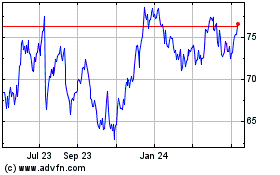BofA to Layoff 40,000 Workers - Analyst Blog
September 09 2011 - 8:35AM
Zacks
Bank of America Corp. (BAC) is mulling over
retrenching 40,000 workers under the first phase of a proposed
restructuring program to recover its financial position, the
Wall Street Journal reported following communication with
people familiar with the plans. The looming layoff scenario does
not come as a surprise from a company fraught with a $1 trillion
problem-loan portfolio. The ongoing economic and market instability
has compounded the quandary.
According to the report, BofA officials have already discussed
the layoffs and chief executive Brian Moynihan is expected to work
out the move on Monday. The number of layoffs could change
following discussions with the CEO.
However, according to the source, the upcoming job cuts could
exceed 30,000 to 35,000 layoffs that the company had in 2008 when
the economy was at the height of recession and BofA was in the
process of taking over Merrill Lynch.
Last month, BofA had announced plans to axe 3,500 workers this
quarter. Thousands of additional layoffs were expected to ensue in
the upcoming quarters, but the expected number of about 10,000 was
substantially lower than the figure now feared.
BoA was one of the biggest victims of the 2007 housing bubble.
Its share price has plummeted about 85% since then. Despite taking
several restructuring initiatives, the company has still not been
able to come out of the crisis.
Moreover, the lawsuit filed by the U.S. Federal Housing Finance
Agency (FHFA) on September 2, 2011 for infringing commitments on
the quality of mortgage securities sold to Fannie Mae and Freddie
Mac is expected to severely impact BofA’s financials in the
upcoming quarters. At such a crucial moment of fluctuating world
economy, a compensation of billions would make it difficult for
BofA to gain ground any time soon.
However, the company has been relentlessly trying to realign its
balance sheet in accordance with the regulatory changes post
meltdown to remain afloat. In fact, BofA remains committed to shed
its non-core assets, even after repaying the bailout money it had
taken as part of its participation in the Troubled Asset Relief
Program.
Primarily, the company has been selling non-core assets to
strengthen its capital position to reinstate dividend hike, meet
new international capital standards, focus on corporate borrowers
and U.S. retail clients as well as strengthen investment
banking.
BofA is looking to concentrate more on businesses that directly
serve customers as well as strengthen its balance sheet. We do not
see an end to this non-core divestiture in the recent future. With
BofA’s plan to boost dividend in the second half of 2011 being
turned down by the Federal Reserve in March, the company sees this
as a way to improve capital strength and fortify its balance
sheet.
Besides, earlier this week, the company announced an immediate
reshuffling of its top management, including the departure of two
executives. The reorganization aligns the company’s operating units
according to its key customer groups -- individuals, companies and
institutional investors.
The management reshuffling is part of BofA’s cost-cutting
program called Project New BAC, which it started in April 2011. The
latest actions are part of the first phase of New BAC. The bank
intends to implement more changes with the second phase beginning
October and running through March 2012.
The whole intention behind this streamlining move is to remove a
layer of operations management, aligning leaders with the company’s
customer groups and simplifying the role and structure of the
management team. According to Moynihan, de-layering and simplifying
at the scale in which the company operates requires tricky
decisions.
The company is significantly optimistic about the success of its
management reshuffling. We, however, don’t think BofA will be able
to overcome all its concerns with the management reshuffling at
least in the near to medium term.
Nevertheless, the company is making every effort to save its own
skin. It is initiating several actions to remain afloat. The job
cut initiative explains BofA’s attempt to improve profitability
amid revenue headwinds due to a weak economy and stricter capital
requirements by regulators.
Notably, BofA is not the only institution doing this dirty job
of rendering so many jobless. Among other U.S. banks, last month,
Bank of New York Mellon Corp (BK) said that it
will slash about 1,500 jobs, which represents about 3% of its total
workforce. State Street Corp. (STT) also plans to
let go 850 technology jobs through layoffs and outsourcing.
While the layoff story is doing rounds once again, raising the
recession alarm and spreading panic among the corporate clan, some
good news came from another banking giant, earlier this week. The
investment banking Chief Executive of JPMorgan Chase &
Co.’s (JPM) said that the company has no plans to retrench
employees in the near future.
Overall, until revenue generation revives, a hideous
cost-to-income ratio will continue to force many more banks to
reduce costs through job cuts as they need to maximize profits in
order to boost capital ratios. If an industry behemoth like BofA
embarks on such ruthless execution, we wonder what job cut schemes
the other weakly performing firms have in store. We keep an eye on
those…
BANK OF AMER CP (BAC): Free Stock Analysis Report
BANK OF NY MELL (BK): Free Stock Analysis Report
JPMORGAN CHASE (JPM): Free Stock Analysis Report
STATE ST CORP (STT): Free Stock Analysis Report
Zacks Investment Research
State Street (NYSE:STT)
Historical Stock Chart
From May 2024 to Jun 2024

State Street (NYSE:STT)
Historical Stock Chart
From Jun 2023 to Jun 2024
